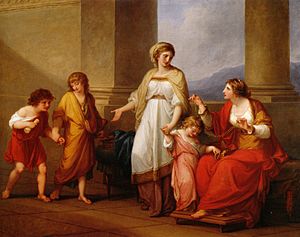Sempronia (sister of the Gracchi) facts for kids
Quick facts for kids
Sempronia
|
|
|---|---|
| Born | |
| Died | |
| Spouse(s) | Scipio Aemilianus |

Sempronia (born around 170 BC – died after 101 BC) was an important Roman noblewoman. She lived during the Middle and Late Roman Republic. Sempronia is best known as the sister of two famous Roman politicians, Tiberius Gracchus and Gaius Gracchus. She was also the wife of a well-known Roman general, Scipio Aemilianus.
Contents
Sempronia's Family Background
Sempronia was the oldest child and only daughter of Tiberius Sempronius Gracchus. Her father was a Roman consul and censor. A consul was a top elected official, like a president. A censor was an official who kept track of citizens and their behavior. Her mother was Cornelia, a very respected woman.
Sempronia had two younger brothers, Tiberius Gracchus and Gaius Gracchus. Both became famous Roman politicians. Her grandparents were the great general Scipio Africanus and his wife Aemilia Paulla. Her great-uncle was also a distinguished general, Lucius Aemilius Paulus Macedonicus. Sempronia's father was known as a strong general and a popular censor.
Sempronia was born in Rome around 170 BC. She grew up and was educated there by her mother. Her father passed away suddenly in 154 BC. It is likely she was already engaged before he died.
Marriage to Scipio Aemilianus
Sempronia married Scipio Aemilianus around 151 BC. He was her mother's cousin and also adopted by her mother's brother. Scipio was a wealthy and educated man. He was part of a group of thinkers called the Scipionic Circle. Scipio later became a famous Roman general.
Some historical stories say that Sempronia and Scipio did not have a happy marriage. They did not show much affection for each other. Sempronia also did not have any children during their marriage.
The couple also disagreed about Scipio's actions towards Sempronia's brother, Tiberius Gracchus. Tiberius had tried to make a peace agreement for a Roman army. Scipio spoke against this agreement in the Senate, which was Rome's governing council. Even though Tiberius was not punished, he felt upset with Scipio. Tiberius later became a tribune, a leader who protected the common people. He wanted to make big changes to Roman society.
In 133 BC, Tiberius Gracchus and some of his supporters were killed in Rome. This happened during a time of political unrest. Scipio was away fighting in Spain at the time. When he returned, he reportedly said that Tiberius had tried to become too powerful. This suggested that Tiberius's death was understandable under Roman traditions. Some people thought Scipio was involved in Tiberius's death.
Scipio's popularity among Roman citizens dropped after this event. However, he remained an important speaker in the Senate.
The Mysterious Death of Scipio
In 129 BC, Scipio planned to speak against Tiberius Gracchus's land reforms. He told his allies about his plans. One of Tiberius's supporters, Gaius Papirius Carbo, was a strong opponent of Scipio.
Scipio went to bed early, planning to give his important speech the next day. The following morning, he was found dead in his bed. He had not been sick before. His body was quickly cremated, which was unusual for his family.
Rumors spread that Scipio had been murdered. Some people suspected his wife, Sempronia, and her mother, Cornelia Africana. However, the real cause of Scipio's death is still unknown. There is no clear proof that Sempronia was involved. The Senate's reaction to the death of such a great general was also unusual.
Today, many historians think that if Scipio was murdered, Carbo was likely responsible. A Roman historian named Cicero later wrote that Carbo was the guilty party. However, Cicero was less sure if Sempronia helped Carbo.
Sempronia's Later Life
After her husband Scipio died, Sempronia lived a quiet life with her mother. Her younger brother, Gaius Gracchus, also died in 121 BC. His property was taken by the Senate. Her mother, Cornelia Africana, passed away later that year. She left her property to her infant granddaughter, also named Sempronia.
Years after Scipio's death, Sempronia was involved in another public event. Around 100 BC, a Roman politician named Lucius Equitus claimed to be the son of Sempronia's brother, Tiberius Gracchus. People were excited about the idea that Tiberius Gracchus might have a living descendant.
Lucius Equitus asked Sempronia to kiss him in public to prove his claim. But Sempronia strongly denied his claim. She would not confirm the rumor. Today, it is widely believed that Lucius Equitus was not related to the Gracchus family at all.
Cultural Depictions
Sempronia is shown in the painting Cornelia, Mother of the Gracchi, Pointing to her Children as Her Treasures. This painting was created by Angelica Kaufmann, an artist from the 1700s.
In the painting, Sempronia is a young girl. She is dressed in pink and holding her mother's hand. This shows Sempronia's innocence and her close bond with her mother, Cornelia.
See also
 In Spanish: Sempronia para niños
In Spanish: Sempronia para niños
- Sempronia gens
Sources
- Sallust, De coniuratione Catilinae xxv
- Plutarch, Makers of Rome, Tiberius Gracchus.
- Valerius Maximus, Factorum et dictorum memorabilium libri iii.8.6, ix.15.1

